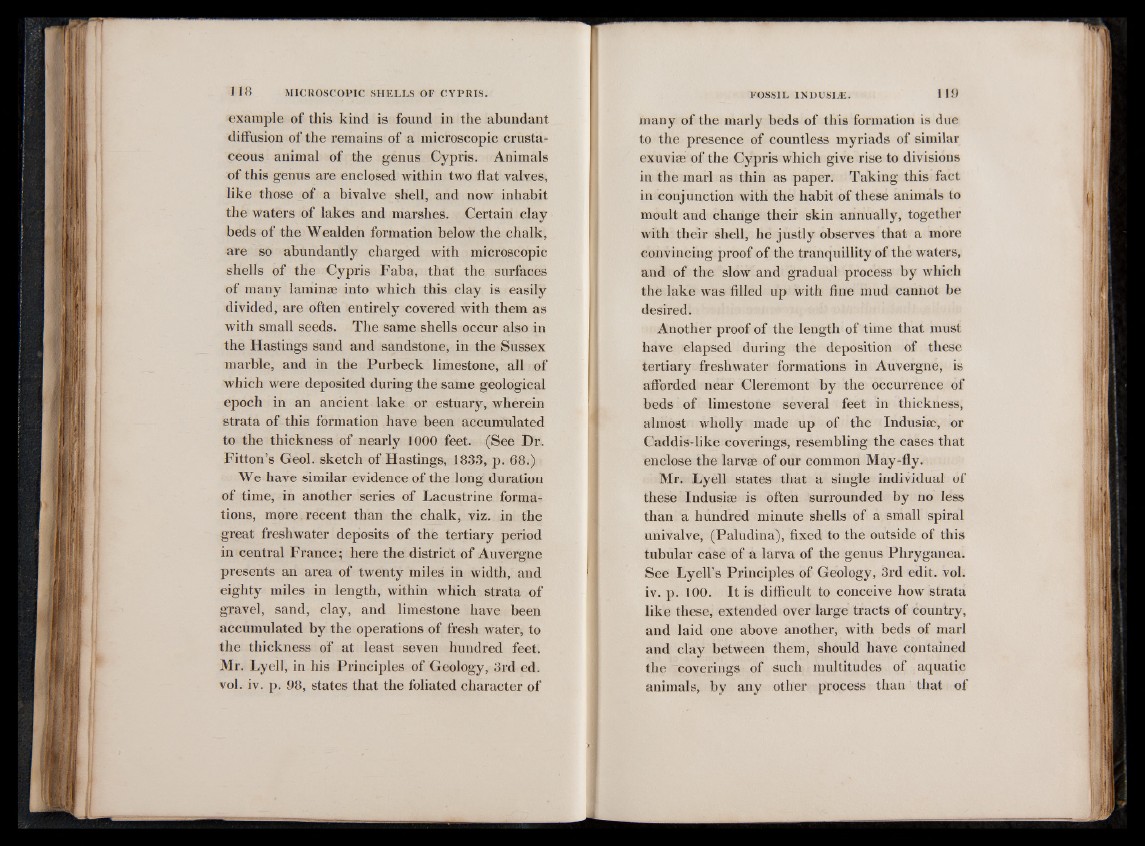
example of this kind is found in the abundant
diffusion of the remains of a microscopic crusta-
ceous animal of the genus Cypris. Animals
of this genus are enclosed within two flat valves,
like those of a bivalve shell, and now inhabit
the waters of lakes and marshes. Certain clay
beds of the Wealden formation below the chalk,
are so abundantly charged with microscopic
shells of the Cypris Faba, that the surfaces
of many laminae into which this clay is easily
divided, are often entirely covered with them as
with small seeds. The same shells occur also in
the Hastings sand and sandstone, in the Sussex
marble, and in the Purbeck limestone, all of
which were deposited during the same geological
epoch in an ancient lake or estuary, wherein
strata of this formation have been accumulated
to the thickness of nearly 1000 feet. (See Hr.
Fitton’s Geol. sketch of Hastings, 1833, p. 6 8 .)
We have similar evidence of the long duration
of time, in another series of Lacustrine formations,
more, recent than the chalk, viz. in the
great freshwater deposits of the tertiary period
in central France; here the district of Auvergne
presents an area of twenty miles in width, and
eighty miles in length, within which strata of
gravel, sand, clay, and limestone have been
accumulated by the operations of fresh water, to
the thickness of at least seven hundred feet.
Mr. Lyell, in his Principles of Geology, 3rd ed.
vol. iv. p. 98, states that the foliated character of
many of the marly beds of this formation is due
to the presence of countless myriads of similar
exuviae of the Cypris which give rise to divisions
in the marl as thin as paper. Taking this fact
in conjunction with the habit of these animals to
moult and change their skin annually, together
with their shell, he justly observes that a more
convincing proof of the tranquillity of the waters,
and of the slow and gradual process by which
the lake was filled up with fine mud cannot be
desired.
Another proof of the length of time that must
have elapsed during the deposition of these
tertiary freshwater formations in Auvergne, is
afforded near Cleremont by the occurrence of
beds of limestone several feet in thickness,
almost wholly made up of the Indusise, or
Caddis-like coverings, resembling the cases that
enclose the larvae of our common May-fly.
Mr. Lyell states that a single individual of
these Indusiae is often surrounded by no less
than a hundred minute shells of a small spiral
univalve, (Paludina), fixed to the outside of this
tubular case of a larva of the genus Phryganea.
See Lyell’s Principles of Geology, 3rd edit. vol.
iv. p. 100. It is difficult to conceive how strata
like these, extended over large tracts of country,
and laid one above another, with beds of marl
and clay between them, should have contained
the coverings of such multitudes of aquatic
animals, by any other process than that of